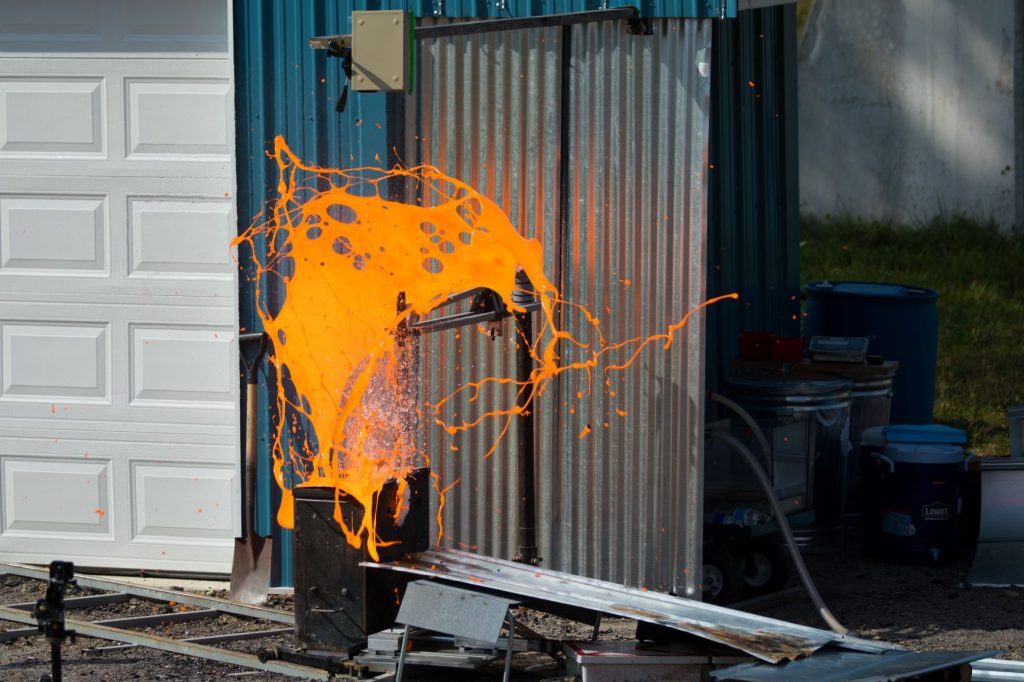10 December 2018
NOTE: AGU will hold a press conference about this research today, Monday, Dec. 10 at 4:00 p.m. EST. See “Notes for Journalists” below for more information.
AGU Press Contact:
Lauren Lipuma, +1 (202) 777-7396, [email protected]
University at Buffalo Press Contact:
Charlotte Hsu, +1 (716) 645-4655, +1 (510) 388-1831, [email protected]
Contact information for the researchers:
Ingo Sonder, [email protected]
WASHINGTON — What happens when lava and water meet? Explosive experiments with manmade lava are helping to answer this important question.

An intense reaction occurs after water is injected into molten rock.
Credit: Douglas Levere / University at Buffalo.
By cooking up 10-gallon batches of molten rock and injecting them with water, scientists at the University at Buffalo are shedding light on the basic physics of lava-water interactions, which are common in nature but poorly understood.
The first results from the project are published today in the Journal of Geophysical Research: Solid Earth, a journal of the American Geophysical Union. The scientists caution that the number of tests so far is small, so the team will need to conduct more experiments to draw firm conclusions.
The research shows that lava-water encounters can sometimes generate spontaneous explosions when there is at least about a foot of molten rock above the mixing point. In prior, smaller-scale studies that used about a coffee cup’s worth of lava, scientists in Germany found that they needed to apply an independent stimulus — in essence pricking the water within the lava — to trigger a blast.
The results reported in JGR: Solid Earth also point to some preliminary trends, showing that in a series of tests, larger, more brilliant reactions tended to occur when water rushed in more quickly and when lava was held in taller containers. (The team ran a total of 12 experiments in which water injection speeds ranged from about 6 to 30 feet per second, and in which lava was held in insulated steel boxes that ranged in height from about 8 to 18 inches.)
“If you think about a volcanic eruption, there are powerful forces at work, and it’s not a gentle thing,” said Ingo Sonder, a research scientist in the Center for Geohazards Studies at UB and lead author of the new study. “Our experiments are looking at the basic physics of what happens when water gets trapped inside molten rock.”
###
The American Geophysical Union is dedicated to advancing the Earth and space sciences for the benefit of humanity through its scholarly publications, conferences, and outreach programs. AGU is a not-for-profit, professional, scientific organization representing 60,000 members in 137 countries. Join the conversation on Facebook, Twitter, YouTube, and our other social media channels.
Notes for Journalists
This paper will be freely available until January 15, 2019. Journalists and public information officers (PIOs) can download a PDF copy of the article by clicking on this link:
https://agupubs.onlinelibrary.wiley.com/doi/pdf/10.1029/2018JB015682
Multimedia accompanying this press release can be downloaded here:
https://buffalo.app.box.com/s/rsixnx9ckmsrzji6c29vvloxqswlaf0v
Lead author Ingo Sonder will discuss these findings in a press conference at the 2018 AGU Fall Meeting today, Monday, 10 December at 4:00 p.m. EST in room Shaw/LeDroit Park on level M3 of the Marriott Marquis hotel, 901 Massachusetts Ave NW, Washington, DC 20001. This press conference will also be streamed live on the AGU press events webpage and a recording of the press conference will be archived on AGU’s YouTube channel. Reporters interested in streaming the press conference and participating remotely should go to the Webstreaming page on the 2018 Fall Meeting Media Center website.
Lead author Ingo Sonder will also present a poster about this research on Tuesday, 11 December from 1:40 – 6:00 p.m. EST in the Walter E. Washington Convention Center, Hall A-C, in session V23J.
Journalists and PIOs may also request a copy of the paper and multimedia by emailing Lauren Lipuma at [email protected]. Please provide your name, the name of your publication, and your phone number.
Neither the paper nor this press release is under embargo.
Paper Title:
“Meter-Scale Experiments on Magma-Water Interaction”
Authors:
Ingo Sonder, Andrew G. Harp, Pranabendu Moitra, Greg A. Valentine: Center for Geohazards Studies, University at Buffalo, Buffalo, New York, U.S.A.;
Alison H. Graettinger: Center for Geohazards Studies, University at Buffalo, Buffalo, New York, U.S.A., and Department of Geosciences, University of Missouri, Kansas City, Missouri, U.S.A.;
Ralf Büttner, Bernd Zimanowski: Physikalisch Vulkanologisches Labor, Universität Würzburg, Würzburg, Germany.